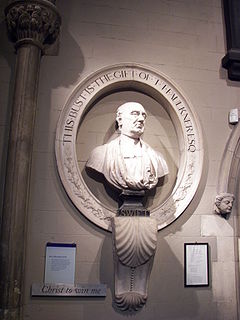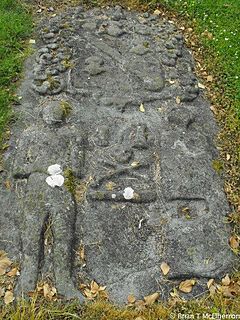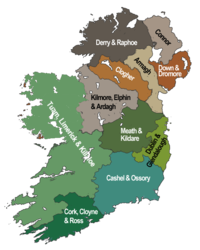
Saint Patrick's Cathedral in Dublin, Ireland, founded in 1191 as a Roman Catholic Cathedral, it is currently the national cathedral of the Church of Ireland. Christ Church Cathedral, also a Church of Ireland cathedral in Dublin, is designated as the local cathedral of the Diocese of Dublin and Glendalough.
Adam Loftus, 1st Viscount Loftus was Lord Chancellor of Ireland from 1619 and from 1622 raised to the peerage of Ireland as Viscount Loftus of Ely, King's County. His uncle, another Adam Loftus, was both Lord Chancellor of Ireland and Church of Ireland primate.

Christ Church Cathedral, more formally The Cathedral of the Holy Trinity, is the cathedral of the United Dioceses of Dublin and Glendalough and the cathedral of the ecclesiastical province of the United Provinces of Dublin and Cashel in the (Anglican) Church of Ireland. It is situated in Dublin, Ireland, and is the elder of the capital city's two medieval cathedrals, the other being St Patrick's Cathedral.

The Dean of St Patrick's Cathedral is the senior cleric of the Protestant St Patrick's Cathedral, Dublin, elected by the chapter of the cathedral. The office was created in 1219 or 1220, by one of several charters granted to the cathedral by Archbishop Henry de Loundres between 1218 and 1220.

The Archdiocese of Dublin is an ecclesiastical territory or archdiocese of the Catholic Church located in the eastern part of Ireland. Its archepiscopal see includes the republic's capital city – Dublin. The cathedral church of the archdiocese is St Mary's Pro-Cathedral. Dublin was formally recognised as a metropolitan province in 1152 by the Synod of Kells. Its second archbishop, Lorcán Ua Tuathail, is also its patron saint.

The United Dioceses of Dublin and Glendalough is a diocese of the Church of Ireland in the east of Ireland. It is headed by the Archbishop of Dublin, who is also styled the Primate of Ireland. The diocesan cathedral is Christ Church Cathedral, Dublin.

The Archbishop of Dublin is a senior bishop in the Church of Ireland, second only to the Archbishop of Armagh. The archbishop is the diocesan bishop of the United Dioceses of Dublin and Glendalough and the metropolitan bishop of the Province of Dublin, which covers the southern half of Ireland, and he is styled Primate of Ireland.

The Dean of Christ Church Cathedral, Dublin is the senior official of that church, the cathedral of the United Diocese of Dublin and Glendalough in the Church of Ireland, and head of the Chapter, its governing body. A Dean has presided over Christ Church Cathedral since around 1539, before which the cathedral was a Priory under Augustinian rules, headed by a Prior, back to the time of Archbishop St. Laurence O'Toole. Aspects of the cathedral administration are overseen by the Cathedral Board, which the Dean chairs.
The Archbishop of Dublin is the head of the Archdiocese of Dublin in the Catholic Church, responsible for its spiritual and administrative needs. The office has existed since 1152, in succession to a regular bishopric since 1028. The archdiocese is the metropolitan see of the ecclesiastical province of Dublin, and the archbishop is also styled the Primate of Ireland. The cathedral church of the archdiocese is Saint Mary's Pro-Cathedral in Dublin city, although the Church formally claims Christ Church as its cathedra, and the archbishop's residence is Archbishop's House in Drumcondra.

The Archbishop of Dublin is an archiepiscopal title which takes its name after Dublin, Ireland. Since the Reformation, there have been parallel apostolic successions to the title: one in the Catholic Church and the other in the Church of Ireland. The archbishop of each denomination also holds the title of Primate of Ireland.
The Archdeacon of Tuam was a post held in the Diocese of Tuam, from the creation of the diocese at the Synod of Rathbreasail in 1111.

The Archdeacon of Dublin is a senior ecclesiastical officer within the Anglican Diocese of Dublin and Glendalough. As such he or she is responsible for the disciplinary supervision of the clergy within the Dublin part of the diocese, which is by far the largest.

The Archdeacon of Ossory was a senior ecclesiastical officer within the Diocese of Ossory until 1835 and then within the Bishop of Ossory, Ferns and Leighlin until 1977 when it was further enlarged to become the Diocese of Cashel and Ossory. As such he was responsible for the disciplinary supervision of the clergy within the Cloyne Diocese.

The Archdeacon of Kells, alias the Archdeacon of Nobber, was a medieval ecclesiastical post in the Diocese of Meath in the Kingdom of Meath, Ireland. The Archdeaconry was officially established sometime between the 11th and 13th centuries, and was annexed to the Rectory of Nobber. In the 16th Century, the office was briefly united to the Bishopric of Meath, but afterwards separated again. As a consequence of the Reformation, the Archbishop of Armagh held the "Archdeacony of Kells, in commendam 1569 to 1584". Sometime before 1622, the Archdeacon of Kells and Rectory of Nobber were permanently united to the bishopric of Meath.

The Archdeacon of Ardfert was a senior ecclesiastical officer within the Anglican Diocese of Limerick, Ardfert and Aghadoe from the early thirteenth century to the early twentieth. As such he was responsible for the disciplinary supervision of the clergy within his part of the Diocese of Ardfert ; and then the combined diocese of Limerick, Ardfert and Aghadoe.

The Archdeacon of Armagh is a senior ecclesiastical officer within the Anglican Diocese of Armagh. The Archdeacon is responsible for the disciplinary supervision of the clergy within the Diocese.

The Archdeacon of Killaloe was a senior ecclesiastical officer within the Diocese of Killaloe until 1752; and then within the Diocese of Killaloe and Kilfenora until 1832 when it became the Diocese of Killaloe and Clonfert. As such he was responsible for the disciplinary supervision of the clergy within the diocese.

The Archdeacon of Achonry was a senior ecclesiastical officer within the Diocese of Achonry until 1622;Killala and Achonry from 1622 until 1834; and of Tuam, Killala and Achonry from 1834, although it has now been combined to include the area formerly served by the Archdeacon of Killala As such he was responsible for the disciplinary supervision of the clergy within his portion of the diocese. within the diocese. The Archdeaconry can trace its history back to Denis O'Miachain who in 1266 became bishop of the dioces to the last discrete incumbent George FitzHerbert McCormick.

The Archdeacon of Killaloe, Kilfenora, Clonfert and Kilmacduagh is a senior ecclesiastical officer within the Anglican Diocese of Limerick and Killaloe. As such he or she is responsible for the disciplinary supervision of the clergy within the Diocese. The current incumbent is Wayne Carney.
Neal John O'Raw has been the Church of Ireland Archdeacon of Glendalough since 2018.









